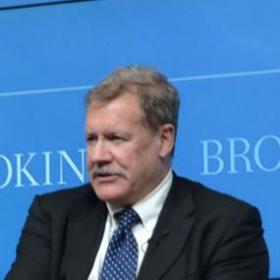
Recalling Asian History and Making It
Greg Austin wrote this piece for his weekly column in New Europe.
As Europeans head for the beaches and mountains over summer, they might recall anniversaries this week of two major events some 65 years ago – the opening of the Potsdam Conference in 1945 on 17 July and the first test of the atomic bomb in Alamogordo New Mexico the previous day.
At the Cecilienhof Palace in Germany, Truman, Churchill and Stalin met to map out the future of Europe after the Second World War and to show Allied unity in the final stages of the war against Japan. Many of the agreements signed then shaped the course of history in Europe for the generations that followed. But the conference also set the course of events in Asia in the coming decade. The Declaration signed by the three war-time allies was in fact about ending the war in Asia, where all three had territorial interests and geopolitical ambitions.
The first article said that Japan would be given an opportunity to end the war, and the second warned that “The prodigious land, sea and air forces of the United States, the British Empire and of China, many times reinforced by their armies and air fleets from the west, are poised to strike the final blows upon Japan.” The ultimatum called for the unconditional surrender of Japan and, if it did not, threatened the “prompt and utter destruction of Japan”.
The Allies did not need the atomic bomb to make such a threat. The fire bombing of Tokyo over just two days in March destroyed almost 300,000 buildings and killed almost 100,000 people. Bombings led by Air Force General Curtis LeMay destroyed more than 50 per cent of all building in 30 Japanese cities in the six months before Potsdam. But the United States did use the atomic bomb just days after the Potsdam Conference concluded.
Well, 65 years later, the Americans and Europeans are still making history in Asia, and in some of its most remote parts. In Kabul on 20 July, the Afghanistan government will host the first ever international conference of its kind in the country itself on national reconstruction and development. According to the Afghanistan government, the meeting of more than seventy countries “marks a new phase in Afghanistan’s engagement with the international community”. One aim is to “mobilize international confidence and resources for a new generation of “bankable” national programs”, albeit in accordance with “ President Karzai’s inaugural speech of November 2009”. The clear message of that speech was that the future security of Afghanistan will be determined more by what the people of Afghanistan and neighboring countries want, rather than by the United States or its NATO allies. That is of course the ideal. What the Afghanistan government would prefer is that those distant countries retreat from political interference in the country while still providing aid. President Karzai is more comfortable with support from Asian countries.
Japan and the Asian Development Bank each provide more aid to Afghanistan then the European Commission, while India, Iran, Pakistan, the UAE and China are also important donors. But the UK provides more and military forces than any Asian country and the United States contribution to civilian is more than ten times that of the top Asian donor, Japan.
The question Asia’s leaders must ponder going into the Kabul Conference is just how much they want their region’s history to continue to be shaped so profoundly from Washington and London. Many Asians are comfortable with the “old” powers playing this role. But 65 years after the beginning of the end of imperialism and colonialism, wealthy Asian governments need to get organized among themselves and shoulder more responsibility for regional security.

